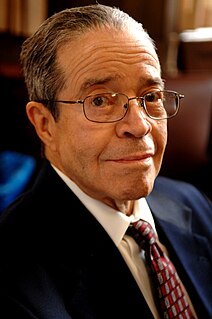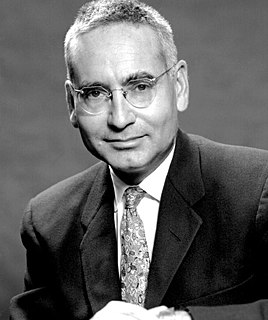This article includes a list of general references, but it lacks sufficient corresponding inline citations .(November 2013) |
The following is a list of things named after Hungarian physicist E. P. Wigner.
This article includes a list of general references, but it lacks sufficient corresponding inline citations .(November 2013) |
The following is a list of things named after Hungarian physicist E. P. Wigner.

Eugene Paul "E. P." Wigner was a Hungarian theoretical physicist who also contributed to mathematical physics. He obtained American citizenship in 1937, and received the Nobel Prize in Physics in 1963 "for his contributions to the theory of the atomic nucleus and the elementary particles, particularly through the discovery and application of fundamental symmetry principles".

Oak Ridge National Laboratory (ORNL) is a U.S. multiprogram science and technology national laboratory sponsored by the U.S. Department of Energy (DOE) and administered, managed, and operated by UT–Battelle as a federally funded research and development center (FFRDC) under a contract with the DOE, located in Oak Ridge, Tennessee.
The ORACLE or Oak Ridge Automatic Computer and Logical Engine, an early computer built by Oak Ridge National Laboratory, was based on the IAS architecture developed by John von Neumann.

The Aircraft Reactor Experiment (ARE) was an experimental nuclear reactor designed to test the feasibility of fluid-fuel, high-temperature, high-power-density reactors for the propulsion of supersonic aircraft. It operated between November 8-12, 1954 at the Oak Ridge National Laboratory (ORNL) with a maximum sustained power of 2.5 megawatts (MW), and generated a total of 96 MW-hours of energy.

The Aircraft Nuclear Propulsion (ANP) program and the preceding Nuclear Energy for the Propulsion of Aircraft (NEPA) project worked to develop a nuclear propulsion system for aircraft. The United States Army Air Forces initiated Project NEPA on May 28, 1946. NEPA operated until May 1951, when the project was transferred to the joint Atomic Energy Commission (AEC)/USAF ANP. The USAF pursued two different systems for nuclear-powered jet engines, the Direct Air Cycle concept, which was developed by General Electric, and Indirect Air Cycle, which was assigned to Pratt & Whitney. The program was intended to develop and test the Convair X-6, but was canceled in 1961 before that aircraft was built. The total cost of the program from 1946 to 1961 was about $1 billion.

The X-10 Graphite Reactor is a decommissioned nuclear reactor at Oak Ridge National Laboratory in Oak Ridge, Tennessee. Formerly known as the Clinton Pile and X-10 Pile, it was the world's second artificial nuclear reactor, and the first designed and built for continuous operation. It was built during World War II as part of the Manhattan Project.

Jesse Ernest Wilkins Jr. was an African American nuclear scientist, mechanical engineer and mathematician. A child prodigy, he attended the University of Chicago at the age of 13, becoming its youngest ever student. His graduation at a young age resulted in him being hailed as "the Negro Genius" in the national media.

Alvin Martin Weinberg was an American nuclear physicist who was the administrator at Oak Ridge National Laboratory (ORNL) during and after the Manhattan Project. He came to Oak Ridge, Tennessee, in 1945 and remained there until his death in 2006. He was the first to use the term "Faustian bargain" to describe nuclear energy.
Eugene Feenberg was an American physicist who made contributions to quantum mechanics and nuclear physics.
Nikolaus Riehl was a German industrial physicist. He was head of the scientific headquarters of Auergesellschaft. When the Russians entered Berlin near the end of World War II, he was invited to the Soviet Union, where he stayed for 10 years. For his work on the Soviet atomic bomb project, he was awarded a Stalin Prize, Lenin Prize, and Order of the Red Banner of Labor. When he was repatriated to Germany in 1955, he chose to go to West Germany, where he joined Heinz Maier-Leibnitz on his nuclear reactor staff at Technische Hochschule München (THM); Riehl made contributions to the nuclear facility Forschungsreaktor München (FRM). In 1961 he became an ordinarius professor of technical physics at THM and concentrated his research activities on solid state physics, especially the physics of ice and the optical spectroscopy of solids.
Hans-Joachim Born was a German radiochemist trained and educated at the Kaiser-Wilhelm-Institut für Chemie. Up to the end of World War II, he worked in Nikolaj Vladimirovich Timofeev-Resovskij's Abteilung für Experimentelle Genetik, at the Kaiser-Wilhelm-Institut für Hirnforschung. He was taken prisoner by the Russians at the close of World War II. After rescue from the Krasnoyarsk PoW camp, he initially worked in Nikolaus Riehl's group at Plant No. 12 in Elektrostal’, Russia, but at the end of 1947 was sent to work in Sungul' at a sharashka known under the cover name Ob’ekt 0211. At the Sungul' facility, he again worked in a biological research department under the direction of Timofeev-Resovskij. Upon arrival in East Germany in the mid-1950s, Born became the director of the Institut für Angewandte Isotopenforschung in Buch, Berlin. He also completed his Habilitation at the Technische Hochschule Dresden, where he then also became a professor on the Fakultät für Kerntechnik. In 1957, he received and accepted a call to become a professor of radiochemistry at the Technische Hochschule München in West Germany.
CHARISSA is a nuclear structure research collaboration originally conceived, initiated and partially built by Dr. William Rae of the University of Oxford (retired) and now run by the School of Physics and Astronomy at the University of Birmingham, UK. The other members of the collaboration are the University of Surrey with occasional contributions from LPC CAEN and Ruđer Bošković Institute, Zagreb. The collaboration is funded by the Science and Technology Facilities Council (STFC).
The Blue Hills Nuclear Power Plant was a proposed commercial nuclear power plant 20 miles northeast of Jasper, Texas. It was proposed in the 1970s by the Gulf States Utilities Company. One 918 MWe pressurized water reactor was ordered in 1973, and an additional 918 MWe reactor was ordered in 1974 from Combustion Engineering. The two unit power plant proposal was canceled in 1978.
Clarence Edward Larson was an American chemist, nuclear physicist and industrial leader. He was involved in the Manhattan Project, and was later director of Oak Ridge National Laboratory and commissioner of the U.S. Atomic Energy Commission.
Francis Lee Friedman was a professor of physics at the Massachusetts Institute of Technology (MIT).

Edward Creutz was an American physicist who worked on the Manhattan Project at the Metallurgical Laboratory and the Los Alamos Laboratory during World War II. After the war he became a professor of physics at the Carnegie Institute of Technology. He was Vice President of Research at General Atomics from 1955 to 1970. He published over 65 papers on botany, physics, mathematics, metallurgy and science policy, and held 18 patents relating to nuclear energy.
Herbert G. MacPherson was an American nuclear engineer and deputy director of Oak Ridge National Laboratory (ORNL). He contributed to the design and development of nuclear reactors and in the opinion of Alvin Weinberg he was "the country's foremost expert on graphite"...

Theodore A. Welton was an American physicist best known as the co-author of the fluctuation dissipation theorem. During 1944 and 1945 he worked at Project Y in Los Alamos, New Mexico on nuclear weapons in Richard Feynman's T-4 Group after being recruited by Feynman.

Clarice Evone Phelps is an American nuclear chemist researching the processing of radioactive transuranic elements at the US Department of Energy's Oak Ridge National Laboratory (ORNL). She was part of ORNL's team that collaborated with the Joint Institute for Nuclear Research to discover tennessine. The International Union of Pure and Applied Chemistry (IUPAC) recognizes her as the first African-American woman to be involved with the discovery of a chemical element.
Gale J. Young (1912–1990) was an American engineer, mathematical physicist, biophysicist, and applied mathematician. He is known as a pioneer of nuclear engineering and as one of the namesakes of the Eckart-Young theorem in linear algebra.